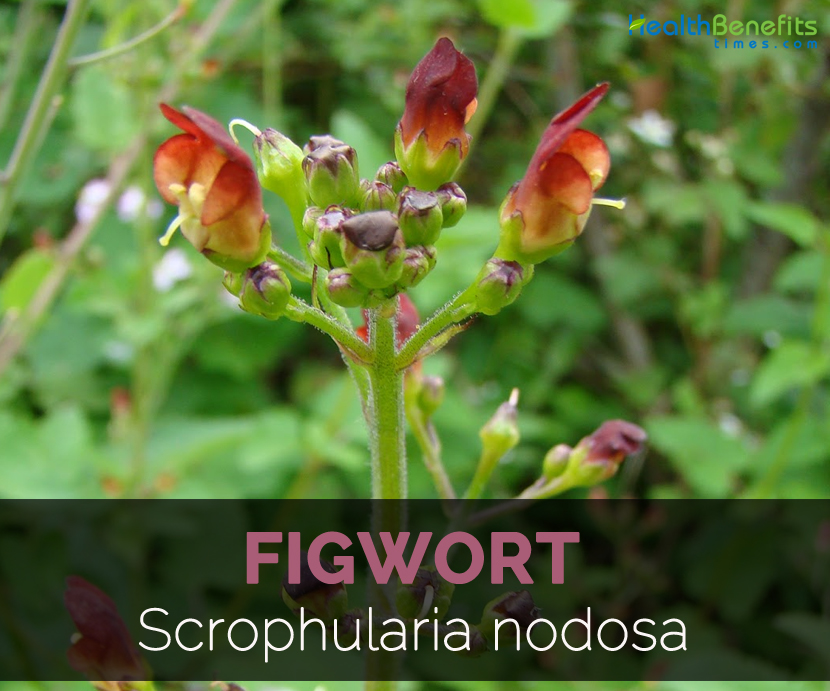| Figwort Quick Facts | |
|---|---|
| Name: | Figwort |
| Scientific Name: | Scrophularia nodosa |
| Origin | Native to Europe, North America and Central Asia. |
| Colors | Green |
| Shapes | Ovate to oblong capsule, egg shaped |
| Taste | Bitter |
The main constituents of Figworts are amino acids, flavonoids, phenolic acids (such as acid, caffeic acid, vanillic acid, cinnamic acid), saponins, phytosterols, cardiac glycoside, asparagine, essential fatty acids, diosmine, acids (such as caffeic, ferulic, cumaric), alkaloids, sucrose, mineral salts, mannitol, resin, iridoids, hesperetin. Figwort possesses depurative, anodyne and diuretic properties which promotes detoxification and cleansing, soothe pain and activates blood circulation. This herb is also used in homeopathic medicines in the forms of ointments, teas, poultices, decoctions and tinctures for treating various health conditions.
Plant
The plant belongs to Scrophulariaceae family which reaches to the height of 3 feet and blooms in summer. The knobby rootstock is whitish and fibrous inside and brown outside. The glabrous, quadrangular and erect stem is composed of ovate to lanceolate leaves that are serrate and opposite and provides an offensive odor. Flowers are red to yellow and usually in round shapes. It attracts wasps which is responsible for pollination.
Fruit and Flower
Flowers are usually reddish to brown and greenish to yellow in color. An individual flower is globular, small and double lipped with brown upper lip and green lower lip. It possesses five petals and sepals. The calyx is five segmented with ovate and narrow to tunicate margined cusps. The swollen and bilabiate corolla is globular tube. It has four stamens and one superior ovary. The fruit is ovary capsule which is pointed green with many seeds.
Stem, Leaves and Root
Figwort plant is perennial and grows up to the height of 50 to 100 cm. Root capitula have ovate and tuberous nodes. It has sharply quadrangular stem that is erect, purple, glabrous and has row of hairs at nodes. Leaves are oblong, dark green, crossed opposite, double serrate and cordate at base.
Traditional uses
- Use it externally for lacrimation, hemorrhoids, venereal warts and earache.
- It also effectively treat rabies.
- Figwort is used as a treatment for tonsillar hypertony and chronic tonsillitis.
- Apply it externally for inflammation of mammage, piles, ringworm, itch, painful swellings and bruises.
- Figwort provides relief from the pain during menstruation.
- It is used to detoxify the body.
- In Middle Ages, it is used as a treatment for tumors and swellings.
- The leaves infusion is a cure for lymphatic disorders, rheumatic conditions, psoriasis and eczema.
- The tincture made from leaves is used for sluggishness and constipation.
- Apply the compresses soaked in an infusion to cure ulcers, wounds and swellings.
- The washes made from infusion are a treatment for skin inflammations, eczema and fungal infections.
- The root decoction is useful for swollen glands, tonsillitis and throat problems.
- It also eliminates worms from the body.
- The decoction made from root of Figwort is used to treat problems associated with throat, swollen glands and tonsillitis.
- It also heals abscesses and swellings of lymphatic glands.
- In Asia, it is used to provide relief from sore throat, fevers and swollen red eyes related to adrenal deficiency and general toxemia.
- The infusion or tea made from Figwort is used to clear accumulation of toxic substances in the body and useful for nodes, lymphatic glands, rheumatic problems, skin problems such as scabies, eczema, scurf, psoriasis, rashes and pruritis.
- Prepare a bath with floral stalks to relieve rheumatism and foot aches.
- Apply an ointment of figwort plant to wounds, bruises, scratches, ulcers and sore swellings.
- Apply the crushed leaves to swellings and burns.
- Use Figwort tea to stimulate lymphatic system, blood & circulatory system, treat psoriasis & eczema, heal burns, treat ulcers and hemorrhoids.
- In Europe, Figwort tea is believed to possess anti-tumor properties.
Precautions
- It might interact with other medicines.
- The pregnant and lactation women should avoid its use.
- The people with ventricular tachycardia and heart problems should not use it.
- Consult a health physician before using it medicinally.
- Figwort should not be given to children.
- This plant possesses cardiac glycosides that affect heart.
- Its excessive use causes diarrhea and vomiting.
- The high content of saponins dilute blood severely and leads to serious side effects.
- The people with diabetes should monitor levels of blood sugar with the use of figwort.
References:
https://www.itis.gov/servlet/SingleRpt/SingleRpt?search_topic=TSN&search_value=34039#null
http://davesgarden.com/guides/pf/go/54556/
http://pfaf.org/user/Plant.aspx?LatinName=Scrophularia+nodosa
http://www.floracatalana.net/scrophularia-nodosa-l-
https://www.herbal-supplement-resource.com/common-figwort.html
https://en.wikipedia.org/wiki/Scrophularia_nodosa
https://www.anniesremedy.com/scrophularia-nodosa-figwort.php
http://www.cloverleaffarmherbs.com/figwort/
https://www.gardeningknowhow.com/ornamental/foliage/figwort/figwort-plant-information.htm
http://www.herbs2000.com/herbs/herbs_figwort.htm
https://www.britannica.com/plant/figwort
http://medicinalherbinfo.org/herbs/Figwort.html
http://medicinalherbals.net/figwort-scrophularia-nodosa-natural-skin-healer/
Comments
comments
